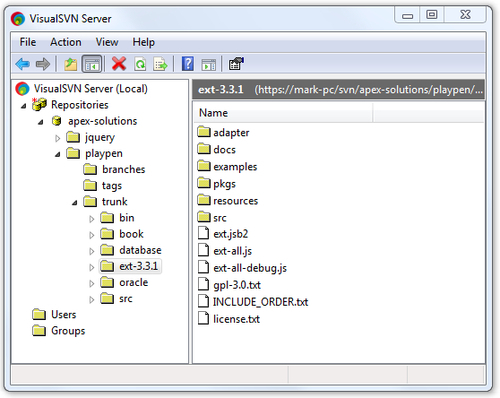
For example: With the repository created, the next step is to make it accessible remotely. There’s really not much to say about Visual Studio support because Subversion and Tortoise don’t work inside of Visual Studio. Type in svn:// / and you should land at your repository. If you have many projects, it’s probably a good idea to have a layout that groups things nicely. How to use VisualSVN Server and TortoiseSVN client. Natively, Subversion runs through a Daemon service that uses TCP/IP. Remember that Subversion uses Copy-Modify-Merge style, which means that files are never locked (unless you explicitly do so) and you can freely change source files. ): You should ensure that the paths in this command line match your installation and repository paths. I like a separate “Project Group/Solution” type folder so I can use it to hold Solution files and as a “header” folder that serves as a grouping for the subprojects.

One thing that’s definitely easier is creation of new projects-you can just use Add to Subversion and VisualSVN will take care of creating the branch and checking out the files for you. I’ll walk you through the process of creating a new repository and adding a Visual Studio Solution with a couple of projects to it. Delete (using VisualSVN Server Manager, still) the old repository.Īgain, you need to tell all other developers working on this project about the rename, because each one (each 'client') needs to do the SVN Relocate thing.How to integrate VisualSVN, TortoiseSVN and Aptana to create a PHP development environment? So, to complete the installation of SVN, we have to install the SVN server and SVN client.Verify that you can view the whole SVN log history, do an SVN-update, etc.it will ask for the SVN URL of the new repository, and then prompt you "are you sure?" (say yes). in Windows Explorer, open up said project's folder and right-click, then under "TortoiseSVN" -> click Relocate."Import existing repository." Specify source & destination (itĬlient-side (meaning, your computer/folder where you've stored your working-copy project/files & actually work on them in Visual Studio): Right there on the home/start page, under "Repositories", click the Login to said server, open the "VisualSVN Server Manager" (GUI) working on it (or can easily tell other dev's about the change so they can follow suit). Assuming, that is, IF you have access to login to the actual server (machine) that runs the VisualSVN server. I was searching for a similar answer and was able to piece together this (surprisingly easy) solution.


 0 kommentar(er)
0 kommentar(er)
